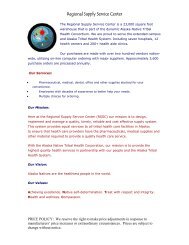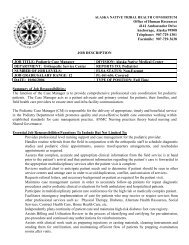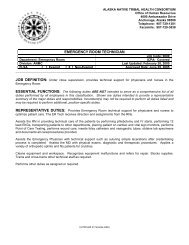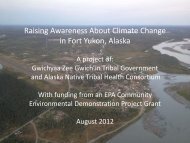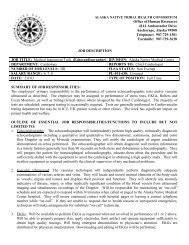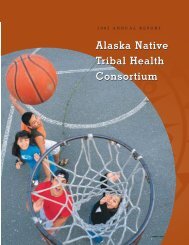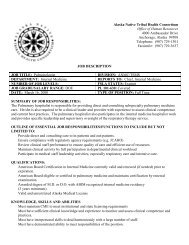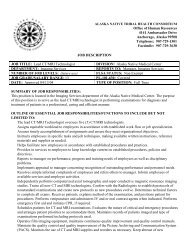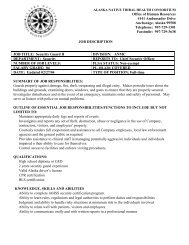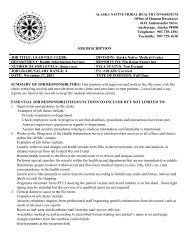Draft Final Climate Change and Health Impacts Point ... - ANTHC
Draft Final Climate Change and Health Impacts Point ... - ANTHC
Draft Final Climate Change and Health Impacts Point ... - ANTHC
You also want an ePaper? Increase the reach of your titles
YUMPU automatically turns print PDFs into web optimized ePapers that Google loves.
Recommendations for <strong>Climate</strong> Adaptation Planning<br />
Local <strong>and</strong> regional government is challenged with preparing for climate‐related impacts, <strong>and</strong> the need to<br />
develop comprehensive adaptation plans. The following are 10 basic principals that are recommended<br />
for integrating climate change planning into local decision‐making. Other principals may be developed<br />
by the community as local residents engage in the planning process.<br />
1. Protection of human life <strong>and</strong> health is the top priority.<br />
2. Traditional values should guide local <strong>and</strong> regional decision making.<br />
3. Development should follow the principles of sustainability “meeting the needs of the present<br />
without compromising the ability of future generations to meet their own needs” (WCED, 1987).<br />
4. Community Adaptation Plans should identify valued local resources, such as subsistence areas,<br />
cultural sites, critical water sources, <strong>and</strong> develop plans to protect them.<br />
5. Critical ecological systems, wetl<strong>and</strong>s, <strong>and</strong> subsistence resource areas should be protected where<br />
possible.<br />
6. Considerations for climate impacts on erosion, flooding, subsistence, water availability, <strong>and</strong><br />
transportation should be incorporated into planning, <strong>and</strong> new infrastructure siting <strong>and</strong> design.<br />
7. Cost‐benefit analyses should be applied to evaluate the social <strong>and</strong> environmental costs of building<br />
<strong>and</strong> maintaining coastal protection structures.<br />
8. Phased ab<strong>and</strong>onment of at‐risk areas should be considered.<br />
9. Coastal emergencies are inevitable <strong>and</strong> disaster response <strong>and</strong> recovery capacity, including<br />
evacuation routes, emergency response plans, drills, <strong>and</strong> shelters, should be reviewed.<br />
10. Building capacity to participate in monitoring, research, <strong>and</strong> advocacy is critical to facilitate<br />
development of effective adaptation strategies.<br />
Specific Recommendations for Adaptation to <strong>Climate</strong> <strong>Change</strong> in <strong>Point</strong> Hope<br />
Adapting to a new climate <strong>and</strong> a changing environment will require significant investments of time,<br />
energy, <strong>and</strong> financial resources if community, social, <strong>and</strong> economic health is to be sustained. New<br />
outside sources of revenue will be needed, as well as the technical assistance of agencies <strong>and</strong><br />
institutions that have expertise in climate adaptation.<br />
Fortunately, the resources that can provide assistance to <strong>Point</strong> Hope are growing, <strong>and</strong> should continue<br />
to grow in the near future. Currently, the State of Alaska is completing a multi‐agency process to<br />
develop a climate change strategy that will help to guide statewide climate policy. Alaska will also be<br />
receiving a new federally funded <strong>Climate</strong> <strong>Change</strong> Response Center that will be administered by the U.S<br />
Geologic Survey.<br />
29



